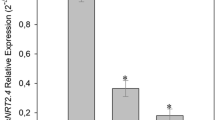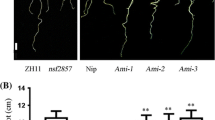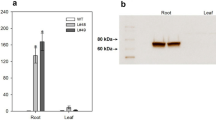Abstract
Main conclusion
Mutation of OsSHR2 adversely impacted root and shoot growth and impaired plant response to N conditions, further reducing the yield per plant.
Abstract
Nitrogen (N) is a crucial factor that regulates the plant architecture. There is still a lack of research on it. In our study, it was observed that the knockout of the SHORTROOT 2 (OsSHR2) which was induced by N deficiency, can significantly affect the regulation of plant architecture response to N in rice. Under N deficiency, the mutation of OsSHR2 significantly reduced root growth, and impaired the sensitivity of the root meristem length to N deficiency. The mutants were found to have approximately a 15% reduction in plant height compared to wild type. But mutants showed a significant increase in tillering at post-heading stage, approximately 26% more than the wild type, particularly in high N conditions. In addition, due to reduced seed setting rate and 1000-grain weight, mutant yield was significantly decreased by approximately 33% under low N fertilizer supply. The mutation also changed the distribution of N between the vegetative and reproductive organs. Our findings suggest that the transcription factor OsSHR2 plays a regulatory role in the response of plant architecture and yield per plant to N in rice.







Similar content being viewed by others
Data availability
No data were used for the study described in the article.
Abbreviations
- SHR:
-
Shortroot
- SLR:
-
Slender rice
- DLT:
-
Dwarf and low-tillering
- N:
-
Nitrogen
References
Akira I, Miyako UT, Yutaka S, Hidemi K, Masaji K, Yuzo F, Makoto M, Junji Y (2001) slender rice, a constitutive gibberellin response mutant, is caused by a null mutation of the SLR1 gene, an ortholog of the height-regulating gene GAI/RGA/RHT/D8. Plant Cell 13(5):999–1010. https://doi.org/10.1105/tpc.13.5.999
Asano K, Hirano K, Ueguchi-Tanaka M, Angeles-Shim RB, Komura T, Satoh H, Kitano H, Matsuoka M, Ashikari M (2009) Isolation and characterization of dominant dwarf mutants, Slr1-d, in rice. Mol Genet Genomics 281(2):223–231. https://doi.org/10.1007/s00438-008-0406-6
Benfey PN, Linstead PJ, Roberts K, Schiefelbein JW, Hauser MT, Aeschbacher RA (1993) Root development in Arabidopsis: four mutants with dramatically altered root morphogenesis. Development 119(1):57–70. https://doi.org/10.1242/dev.119.1.57
Chen J, Fan X, Qian K, Zhang Y, Song M, Liu Y, Xu G, Fan X (2017) pOsNAR2.1:OsNAR2.1 expression enhances nitrogen uptake efficiency and grain yield in transgenic rice plants. Plant Biotechnol J 15(10):1273–1283. https://doi.org/10.1111/pbi.12714
Cui H, Levesque MP, Vernoux T, Jung JW et al (2007) An evolutionarily conserved mechanism delimiting SHR movement defines a single layer of endodermis in plants. Science 316(5823):421–425. https://doi.org/10.1126/science.1139531
Cui H, Hao Y, Kong D (2012) SCARECROW has a SHORT-ROOT-independent role in modulating the sugar response. Plant Physiol 158(4):1769–1778. https://doi.org/10.1104/pp.111.191502
Cui H, Kong D, Liu X, Hao Y (2014) SCARECROW, SCR-LIKE 23 and SHORT-ROOT control bundle sheath cell fate and function in Arabidopsis thaliana. Plant J 78(2):319–327. https://doi.org/10.1111/tpj.12470
Dong W, Zhu Y, Chang H, Wang C, Yang J, Shi J, Gao J, Yang W, Lan L, Wang Y, Zhang X, Dai H, Miao Y, Xu L, He Z, Song C, Wu S, Wang D, Yu N, Wang E (2021) An SHR-SCR module specifies legume cortical cell fate to enable nodulation. Nature 589(7843):586–590. https://doi.org/10.1038/s41586-020-3016-z
Fan X, Tang Z, Tan Y, Zhang Y, Luo B, Yang M, Lian X, Shen Q, Miller AJ, Xu G (2016) Overexpression of a pH-sensitive nitrate transporter in rice increases crop yields. Proc Natl Acad Sci USA 113(26):7118–7123. https://doi.org/10.1073/pnas.1525184113
Gallagher KL, Paquette AJ, Nakajima K, Benfey PN (2004) Mechanisms regulating SHORT-ROOT intercellular movement. Curr Biol 14(20):1847–1851. https://doi.org/10.1016/j.cub.2004.09.081
Gao Z, Wang Y, Chen G, Zhang A, Yang S, Shang L, Wang D, Ruan B, Liu C, Jiang H, Dong G, Zhu L, Hu J, Zhang G, Zeng D, Guo L, Xu G, Teng S, Harberd NP, Qian Q (2019) The indica nitrate reductase gene OsNR2 allele enhances rice yield potential and nitrogen use efficiency. Nat Commun 10(1):5207. https://doi.org/10.1038/s41467-019-13110-8
Gruber BD, Giehl RF, Friedel S, von Wiren N (2013) Plasticity of the Arabidopsis root system under nutrient deficiencies. Plant Physiol 163(1):161–179. https://doi.org/10.1104/pp.113.218453
Guo S, Xu Y, Liu H, Mao Z, Zhang C, Ma Y, Zhang Q, Meng Z, Chong K (2013) The interaction between OsMADS57 and OsTB1 modulates rice tillering via DWARF14. Nat Commun 4:1566. https://doi.org/10.1038/ncomms2542
Hao J, Wang D, Wu Y, Huang K, Duan P, Li N, Xu R, Zeng D, Dong G, Zhang B, Zhang L, Inze D, Qian Q, Li Y (2021) The GW2-WG1-OsbZIP47 pathway controls grain size and weight in rice. Mol Plant 14(8):1266–1280. https://doi.org/10.1016/j.molp.2021.04.011
Helariutta Y, Fukaki H, Wysocka-Diller J, Nakajima K, Jung J, Sena G, Hauser M-T, Benfey PN (2000) The SHORT-ROOT gene controls radial patterning of the Arabidopsis root through radial signaling. Cell 101:555–567. https://doi.org/10.1016/s0092-8674(00)80865-x
Henry S, Dievart A, Divol F, Pauluzzi G, Meynard D, Swarup R, Wu S, Gallagher KL, Perin C (2017) SHR overexpression induces the formation of supernumerary cell layers with cortex cell identity in rice. Dev Biol 425(1):1–7. https://doi.org/10.1016/j.ydbio.2017.03.001
Hsieh PH, Kan CC, Wu HY, Yang HC, Hsieh MH (2018) Early molecular events associated with nitrogen deficiency in rice seedling roots. Sci Rep 8(1):12207. https://doi.org/10.1038/s41598-018-30632-1
Hu B, Wang W, Ou S, Tang J, Li H, Che R, Zhang Z, Chai X, Wang H, Wang Y, Liang C, Liu L, Piao Z, Deng Q, Deng K, Xu C, Liang Y, Zhang L, Li L, Chu C (2015) Variation in NRT1.1B contributes to nitrate-use divergence between rice subspecies. Nat Genet 47(7):834–838. https://doi.org/10.1038/ng.3337
Huang W, Bai G, Wang J, Zhu W, Zeng Q, Lu K, Sun S, Fang Z (2018) Two splicing variants of OsNPF7.7 regulate shoot branching and nitrogen utilization efficiency in rice. Front Plant Sci 9:300. https://doi.org/10.3389/fpls.2018.00300
Huang S, Liang Z, Chen S, Sun H, Fan X, Wang C, Xu G, Zhang Y (2019) A transcription factor, OsMADS57, regulates long-distance nitrate transport and root elongation. Plant Physiol 180(2):882–895. https://doi.org/10.1104/pp.19.00142
Itoh H, Ueguchi-Tanaka M, Sato Y, Ashikari M, Matsuoka M (2002) The gibberellin signaling pathway is regulated by the appearance and disappearance of SLENDER RICE1 in nuclei. Plant Cell 14(1):57–70. https://doi.org/10.1105/tpc.010319
Jia L, Xie Y, Wang Z, Luo L, Zhang C, Pelissier PM, Parizot B, Qi W, Zhang J, Hu Z, Motte H, Luo L, Xu G, Beeckman T, Xuan W (2020) Rice plants respond to ammonium stress by adopting a helical root growth pattern. Plant J 104(4):1023–1037. https://doi.org/10.1111/tpj.14978
Kamiya N, Itoh J, Morikami A, Nagato Y, Matsuoka M (2003) The SCARECROW gene’s role in asymmetric cell divisions in rice plants. Plant J 36(1):45–54. https://doi.org/10.1046/j.1365-313x.2003.01856.x
Khush GS (1999) Green revolution: the way forward. Nat Rev Genet 1(3):189–196. https://doi.org/10.1038/35093585
Koizumi K, Hayashi T, Wu S, Gallagher KL (2012) The SHORT-ROOT protein acts as a mobile, dose-dependent signal in patterning the ground tissue. Proc Natl Acad Sci USA 109(32):13010–13015. https://doi.org/10.1073/pnas.1205579109
Krouk G, Lacombe B, Bielach A, Perrine-Walker F, Malinska K, Mounier E, Hoyerova K, Tillard P, Leon S, Ljung K, Zazimalova E, Benkova E, Nacry P, Gojon A (2010) Nitrate-regulated auxin transport by NRT1.1 defines a mechanism for nutrient sensing in plants. Dev Cell 18(6):927–937. https://doi.org/10.1016/j.devcel.2010.05.008
Li S, Tian Y, Wu K, Ye Y, Yu J, Zhang J, Liu Q, Hu M, Li H, Tong Y, Harberd NP, Fu X (2018) Modulating plant growth-metabolism coordination for sustainable agriculture. Nature 560(7720):595–600. https://doi.org/10.1038/s41586-018-0415-5
Lima JE, Kojima S, Takahashi H, von Wiren N (2010) Ammonium triggers lateral root branching in Arabidopsis in an AMMONIUM TRANSPORTER1;3-dependent manner. Plant Cell 22(11):3621–3633. https://doi.org/10.1105/tpc.110.076216
Lin Q, Zhang Z, Wu F, Feng M, Sun Y, Chen W, Cheng Z, Zhang X, Ren Y, Lei C, Zhu S, Wang J, Zhao Z, Guo X, Wang H, Wan J (2020) The APC/C(TE) E3 ubiquitin ligase complex mediates the antagonistic regulation of root growth and tillering by ABA and GA. Plant Cell 32(6):1973–1987. https://doi.org/10.1105/tpc.20.00101
Liu Y, Wang H, Jiang Z, Wang W, Xu R, Wang Q, Zhang Z, Li A, Liang Y, Ou S, Liu X, Cao S, Tong H, Wang Y, Zhou F, Liao H, Hu B, Chu C (2021) Genomic basis of geographical adaptation to soil nitrogen in rice. Nature 590(7847):600–605. https://doi.org/10.1038/s41586-020-03091-w
Liu Q, Teng S, Deng C, Wu S, Li H, Wang Y, Wu J, Cui X, Zhang Z, Quick WP, Brutnell TP, Sun X, Lu T (2023) SHORT ROOT and INDETERMINATE DOMAIN family members govern PIN-FORMED expression to regulate minor vein differentiation in rice. Plant Cell 35(8):2848–2870. https://doi.org/10.1093/plcell/koad125
Luo L, Zhang Y, Xu G (2020) How does nitrogen shape plant architecture? J Exp Bot 71(15):4415–4427. https://doi.org/10.1093/jxb/eraa187
Luo L, Zhu M, Jia L, Xie Y, Wang Z, Xuan W (2022) Ammonium transporters cooperatively regulate rice crown root formation responding to ammonium nitrogen. J Exp Bot 73(11):3671–3685. https://doi.org/10.1093/jxb/erac059
Paquette AJ, Benfey PN (2005) Maturation of the ground tissue of the root is regulated by gibberellin and SCARECROW and requires SHORT-ROOT. Plant Physiol 138(2):636–640. https://doi.org/10.1104/pp.104.058362
Peng J, Richards DE, Hartley NM, Murphy GP, Devos KM, Flintham JE, Beales J, Fish LJ, Worland AJ, Pelica F, Sudhakar D, Christou P, Snape JW, Gale MD, Harberd NP (1999) “Green revolution” genes encode mutant gibberellin response modulators. Nature 400(6741):256–261. https://doi.org/10.1038/22307
Sakamoto T, Matsuoka M (2008) Identifying and exploiting grain yield genes in rice. Curr Opin Plant Biol 11(2):209–214. https://doi.org/10.1016/j.pbi.2008.01.009
Shimizu H, Tanabata T, Xie X, Inagaki N, Takano M, Shinomura T, Yamamoto KT (2009) Phytochrome-mediated growth inhibition of seminal roots in rice seedlings. Plant Physiol 137(3):289–297. https://doi.org/10.1111/j.1399-3054.2009.01277.x
Song M, Fan X, Chen J, Qu H, Luo L, Xu G (2020) OsNAR2.1 interaction with OsNIT1 and OsNIT2 functions in root-growth responses to nitrate and ammonium. Plant Physiol 183(1):289–303. https://doi.org/10.1104/pp.19.01364
Sozzani R , Cui H, Moreno-Risueno MA, Busch W, Van Norman JM, Vernoux T, Brady SM, Dewitte W, Murray JAH, Benfey PN (2010) Spatiotemporal regulation of cell-cycle genes by SHORTROOT links patterning and growth Nature 466(7302):128–132 https://doi.org/10.1038/nature09143
Spielmeyer W, Ellis MH, Chandler PM (2002) Semidwarf (sd-1), green revolution rice, contains a defective gibberellin 20-oxidase gene. Proc Natl Acad Sci USA 99(13):9043–9048. https://doi.org/10.1073/pnas.132266399
Tong H, Jin Y, Liu W, Li F, Fang J, Yin Y, Qian Q, Zhu L, Chu C (2009) DWARF AND LOW-TILLERING, a new member of the GRAS family, plays positive roles in brassinosteroid signaling in rice. Plant J 58(5):803–816. https://doi.org/10.1111/j.1365-313X.2009.03825.x
Vidal EA, Araus V, Lu C, Parry G, Green PJ, Coruzzi GM, Gutierrez RA (2010) Nitrate-responsive miR393/AFB3 regulatory module controls root system architecture in Arabidopsis thaliana. Proc Natl Acad Sci USA 107(9):4477–4482. https://doi.org/10.1073/pnas.0909571107
Wang E, Wang J, Zhu X, Hao W, Wang L, Li Q, Zhang L, He W, Lu B, Lin H, Ma H, Zhang G, He Z (2008) Control of rice grain-filling and yield by a gene with a potential signature of domestication. Nat Genet 40(11):1370–1374. https://doi.org/10.1038/ng.220
Wang T, Li Y, Song S, Qiu M, Zhang L, Li C, Dong H, Li L, Wang J, Li L (2021) EMBRYO SAC DEVELOPMENT 1 affects seed setting rate in rice by controlling embryo sac development. Plant Physiol 186(2):1060–1073. https://doi.org/10.1093/plphys/kiab106
Weng J, Gu S, Wan X, Gao H, Guo T, Su N, Lei C, Zhang X, Cheng Z, Guo X, Wang J, Jiang L, Zhai H, Wan J (2008) Isolation and initial characterization of GW5, a major QTL associated with rice grain width and weight. Cell Res 18(12):1199–1209. https://doi.org/10.1038/cr.2008.307
Wu S, Lee CM, Hayashi T, Price S, Divol F, Henry S, Pauluzzi G, Perin C, Gallagher KL (2014) A plausible mechanism, based upon SHORT-ROOT movement, for regulating the number of cortex cell layers in roots. Proc Natl Acad Sci USA 111(45):16184–16189. https://doi.org/10.1073/pnas.1407371111
Wu Z, Chen L, Yu Q, Zhou W, Gou X, Li J, Hou S (2019) Multiple transcriptional factors control stomata development in rice. New Phytol 223(1):220–232. https://doi.org/10.1111/nph.15766
Wu K, Wang S, Song W, Zhang J, Wang Y, Liu Q, Yu J, Ye Y, Li S, Chen J, Zhao Y, Wang J, Wu X, Wang M, Zhang Y, Liu B, Wu Y, Harberd NP, Fu X (2020) Enhanced sustainable green revolution yield via nitrogen-responsive chromatin modulation in rice. Science 367(6478):eaaz2046. https://doi.org/10.1126/science.aaz2046
Xiao X, Zhang J, Satheesh V, Meng F, Gao W, Dong J, Zheng Z, An GY, Nussaume L, Liu D, Lei M (2022) SHORT-ROOT stabilizes PHOSPHATE1 to regulate phosphate allocation in Arabidopsis. Nat Plants 8(9):1074–1081. https://doi.org/10.1038/s41477-022-01231-w
Yang X, Wu F, Lin X, Du X, Chong K, Gramzow L, Schilling S, Becker A, Theissen G, Meng Z (2012) Live and let die - the B(sister) MADS-box gene OsMADS29 controls the degeneration of cells in maternal tissues during seed development of rice (Oryza sativa). PLoS One 7(12):e51435. https://doi.org/10.1371/journal.pone.0051435
Yu X, Xia S, Xu Q, Cui Y, Gong M, Zeng D, Zhang Q, Shen L, Jiao G, Gao Z, Hu J, Zhang G, Zhu L, Guo L, Ren D, Qian Q (2020) ABNORMAL FLOWER AND GRAIN 1 encodes OsMADS6 and determines palea identity and affects rice grain yield and quality. Sci China Life Sci 63(2):228–238. https://doi.org/10.1007/s11427-019-1593-0
Xue, He Baoyuan, Qu Wenjing, Li Xueqiang, Zhao Wan, Teng Wenying, Ma Yongzhe, Ren Bin, Li Zhensheng, Li Yiping, Tong (2015) The nitrate inducible NAC transcription factor TaNAC2-5A controls nitrate response and increases wheat yield Plant Physiology 00568. https://doi.org/10.1104/pp.15.00568
Zhang H, Forde BG (1998) An Arabidopsis MADS box gene that controls nutrient-induced changes in root architecture. Science 279(5349):407–409. https://doi.org/10.1126/science.279.5349.407
Zhang J, Nallamilli BR, Mujahid H, Peng Z (2010) OsMADS6 plays an essential role in endosperm nutrient accumulation and is subject to epigenetic regulation in rice (Oryza sativa). Plant J 64(4):604–617. https://doi.org/10.1111/j.1365-313X.2010.04354.x
Zhang ZL, Ogawa M, Fleet CM, Zentella R, Hu J, Heo JO, Lim J, Kamiya Y, Yamaguchi S, Sun TP (2011) SCARECROW-LIKE 3 promotes gibberellin signaling by antagonizing master growth repressor DELLA in Arabidopsis. Proc Natl Acad Sci USA 108(5):2160–2165. https://doi.org/10.1073/pnas.1012232108
Zhang C, Gao L, Sun J, Jia J, Ren Z (2014) Haplotype variation of Green Revolution gene Rht-D1 during wheat domestication and improvement. J Integr Plant Biol 56(8):774–780. https://doi.org/10.1111/jipb.12197
Zhang Z, Sun Y, Ai H, Luo W, Feng B, Sun W, Xu G, Sun S (2018) Expression patterns and regulation of transcription factor gene OsSHR2 in vegetative growth in rice. Chin J Rice Sci 32(5):427–436. https://doi.org/10.16819/j.1001-7216.2018.7037
Zhou J, Jiao F, Wu Z, Li Y, Wang X, He X, Zhong W, Wu P (2008) OsPHR2 is involved in phosphate-starvation signaling and excessive phosphate accumulation in shoots of plants. Plant Physiol 146:1673–1686. https://doi.org/10.1104/pp.107.111443
Acknowledgements
This work was partially supported by the Sanya Yazhou Bay Science and Technology City (SCKJ-JYRC-2023-71), National Key Research and Development Program of China (2021YFF1000404) and National Natural Science Foundation of China (42107428). We would like to thanks to Professor Chuanzao Mao for providing access to the Zhejiang University Agricultural Experimental Station, Changxing County, Zhejiang Province, China, where we planted the experimental materials.
Author information
Authors and Affiliations
Contributions
SSB and HZ conceived and designed research. HZ, XHH, HX and LHX conducted experiments. WXW, XGH and SSB contributed to the resources and supervision. YSS, HX, CMY and SYS analyzed data. HZ and SSB wrote the manuscript. SSB, HZ, SK, HX, XHH and LHX modified the manuscript. All authors read and approved the manuscript.
Corresponding author
Ethics declarations
Conflict of interest
The authors declare that the study was conducted in the absence of any commercial or financial relationship that could be construed as a potential conflict of interest.
Additional information
Communicated by Dorothea Bartels.
Publisher's Note
Springer Nature remains neutral with regard to jurisdictional claims in published maps and institutional affiliations.
Supplementary Information
Below is the link to the electronic supplementary material.
Rights and permissions
Springer Nature or its licensor (e.g. a society or other partner) holds exclusive rights to this article under a publishing agreement with the author(s) or other rightsholder(s); author self-archiving of the accepted manuscript version of this article is solely governed by the terms of such publishing agreement and applicable law.
About this article
Cite this article
Hu, Z., Huang, X., Xia, H. et al. Transcription factor OsSHR2 regulates rice architecture and yield per plant in response to nitrogen. Planta 259, 148 (2024). https://doi.org/10.1007/s00425-024-04400-7
Received:
Accepted:
Published:
DOI: https://doi.org/10.1007/s00425-024-04400-7




